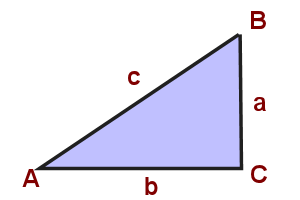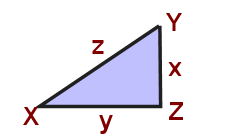Similar Right Triangles
Reference > Mathematics > Trigonometry > Trigonometry - Right TrianglesAs we begin our study of trigonometry, we should understand that trigonometry is based entirely off the concepts of right triangles and similar triangles. In other words, if you've done some basic geometry, you should be able to understand basic trigonometry without difficulty. Consider the following triangles.


These are two right triangles with right angles at C and Z. They are not congruent, however, if I tell you that angle A is equal to angle X, that's enough to conclude that they are similar. The similarity statement for these two triangles is:
ABC ~ XYZ
Since they are similar, we know that the lengths of corresponding sides are in the same ratio. For example, we know that:
a/x = c/z
Let's do some simple manipulation here. In the equation above, multiply both sides by x, and divide both sides by c. This results in the following equation:
a/c = x/z
Let's put that into words: in any two similar right triangles, the ratio of a leg to the hypotenuse of one triangle is equal to the ratio of the corresponding leg to the hypotenuse of the other triangle.
This is an important ratio here, this "leg over hypotenuse" ratio. So let's give it a name. We'll call it the sine of A. And we'll abbreviate it sin A.
How do we calculate sin A? It's the length of the leg opposite angle A, divided by the length of the hypotenuse.
So what is sin B? Well, it's the length of the side opposite angle B, divided by the length of the hypotenuse. That's b/c.
What about sin C? That's a funny one, because there is no leg opposite angle C! Angle C is 90 degrees, and the side opposite is the hypotenuse, not a leg! So our definition doesn't exactly work out. So we're going to leave that alone for now. For now we'll just worry about the acute angles.
We've talked about the ratio of the opposite leg to the hypotenuse - what about the ratio of theadjacent leg to the hypotenuse? We'll call that ratio the cosine of A, and we'll abbreviate it cos A.
Then there's the ratio of the opposite leg to the adjacent leg: a/b. That is referred to as the tangent of A, and we abbreviate that as: tan A.
Summary
In summary, our basic trig functions are:
sin A = a/c
cos A = b/c
tan A = a/b
If we're talking about angle B, we have:
sin B = b/c
cos B = a/c
tan B = b/a
A Mnemonic
How do we remember that? Well, when I was in high school, we were given the following mnemonic: SOHCAHTOA (pronounce it saw-ca-toe-a). This mnemonic serves to remind us:
SINE is OPPOSITE LEG divided by HYPOTENUSE.
COSINE is ADJACENT LEG divided by HYPOTENUSE.
TANGENT is OPPOSITE LEG divided by ADJACENT LEG.
Example #1
In triangle XYZ shown, what are sin X, cos X and tan X?
Solution
The leg opposite angle X is x, the leg adjacent to angle X is y, and the hypotenuse is z, so:
sin X = x/z
cos X = y/z
tan X = x/y
Example #2
In right triangle ABC, with right angle at C, a = 3 and b = 4. What is sin A?
Solution
We can calculate c using the Pythagorean theorem:
c2=32 + 42
c=5.
sin A = a/c = 3/5
Example #3
In right triangle EFG, with right angle at F, e = 5 and f = 13. What is cos E?
Solution
We can calculate g using the Pythagorean theorem:
132=52 + g2
g=12.
cos E = g/f = 12/13
Example #4
In right triangle ABC, with right angle at C, if a is three times b, what is sin A?
Solution
a = 3b, so the Pythagorean theorem gives us
c2 = a2 + (3a)2
c2=10a2
c = ?10a = 3.1623a
Thus sin A = a/c = a/(3.1623a) = .3162
For the questions below, refer to the diagram of triangle ABC.
Questions
 Unit Index
Unit Index Trig Functions on the Calculator
Trig Functions on the Calculator

